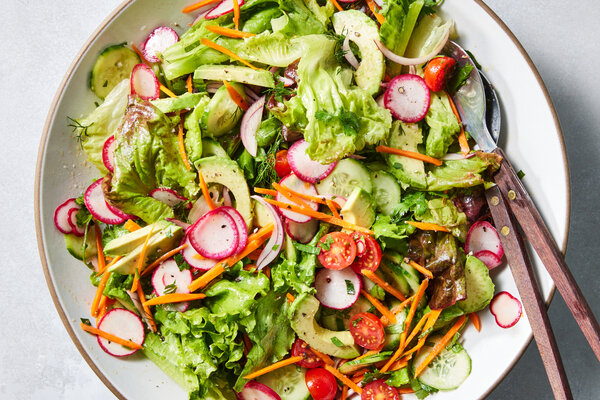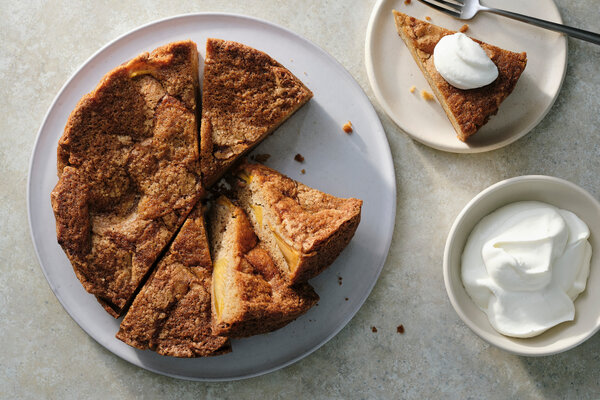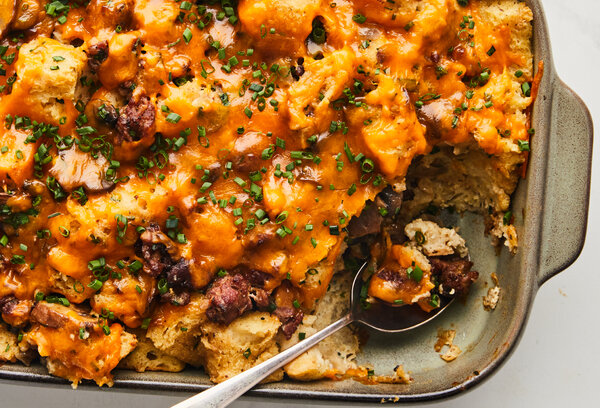You’ll want to commit these recipes to memory.
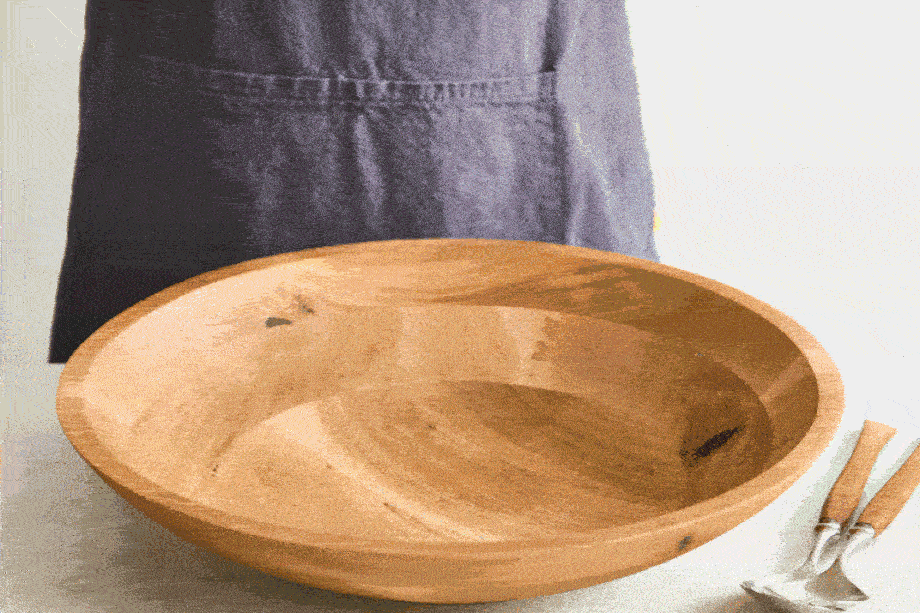
Whether you prefer a light, lovely garden salad or you’re more partial to starchy, satisfying potato salad, there should be something for you to love in the list below.Armando Rafael for The New York Times. Food Stylist: Simon Andrews.
Salad, with its many iterations, wants to defy definition. Many have tried to pin it down, ourselves included, and still, there are versions that prompt reconsideration. Are sweet ambrosias, full of fluffy marshmallows and bound with a whipped cream, technically fruit salads? What moves a sliced tomato into tomato salad territory?
The great unifier is the dressing, turning an unrelated mix of ingredients into a meal. Can we say we had salad until the Egyptians and Babylonians dressed their greens with oil and vinegar nearly 2,000 years ago? Salad has since evolved to include more ingredients and rising to tall, arguably unwieldy, heights in the hands of chefs. It’s become an easy, reliable staple of summer, a perfect meal for the heat, and, sometimes, even the source of a great story. (For example, you may have the actor Cary Grant to thank for Chinese chicken salad.)
Below, you’ll find salads you know and love, the ones that stand above the fold, some with long histories and others that only feel like they’ve been around forever. Consider this curated list the start of a salad journey, with ideal versions alongside recipes that let you riff on classics (think: capreses with stone fruit instead of tomatoes, or white beans in addition). After all, salad likes to keep it fresh. KRYSTEN CHAMBROT
Lidey Heuck’s recipe offers a formula that balances crunchy mild vegetables like carrots with sharper ones like red onion.
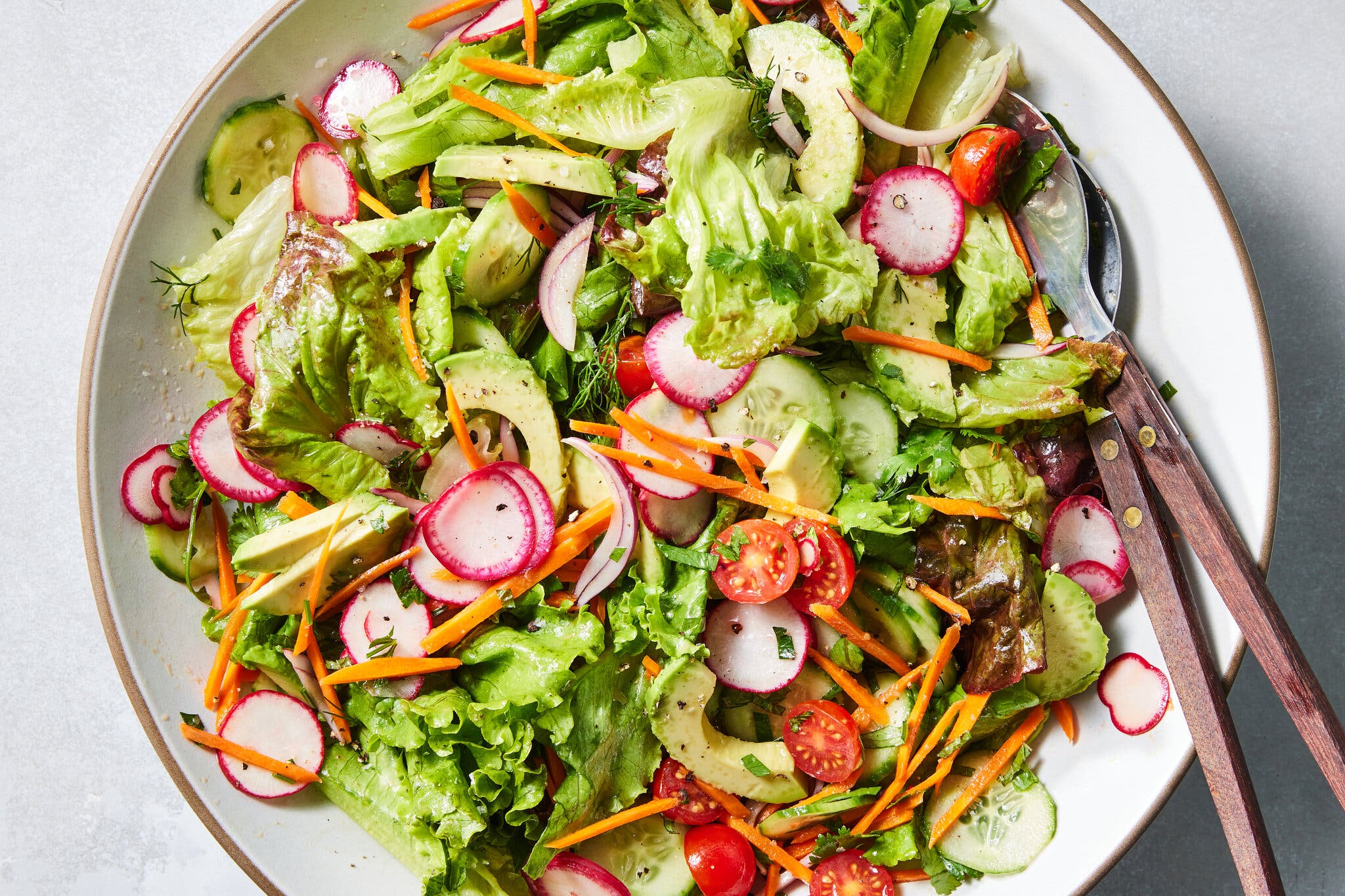
Lidey Heuck’s garden salad.Christopher Testani for The New York Times. Food Stylist: Simon Andrews.
On menus across America, garden salad, sometimes called the house salad, often means a cold, glossily dressed plate of translucent lettuce, pink tomatoes, seedy cucumber and maybe a black olive or two. It’s exactly right if that’s what you’re craving, but the beauty of garden salad is that it can be filled with any vegetables, dressed with any dressing. Ideally, its ingredients are drawn from a garden, real in your backyard or imagined in your dreams. In 1699, John Evelyn’s “Acetaria: A Discourse of Sallets,” the first known English book on salads, was published along with his ninth edition of “Kalendarium Hortense,” a gardener’s almanac. Mr. Evelyn’s approach to this salad starts with growing the vegetables, a practice that modern farm-to-table cooks still embrace. Take that cue and buy whatever vegetables are in season locally and toss with your house dressing. GENEVIEVE KO
The current recipe at Caesar’s, the restaurant where the salad was named, includes whole romaine leaves coated in dressing with Dijon, anchovies and lime. Sliced, not diced, croutons, please.
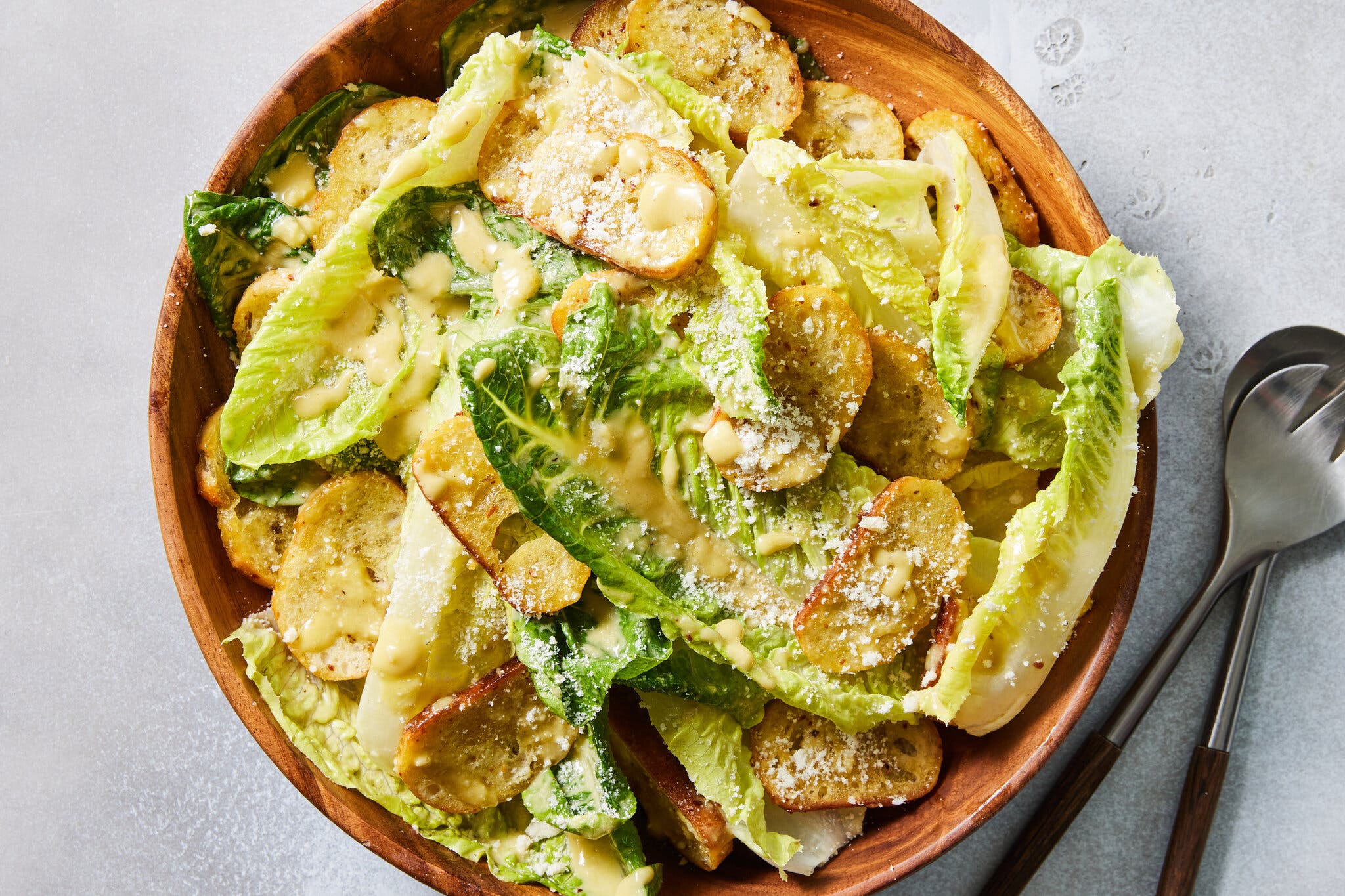
Caesar’s Caesar salad.Christopher Testani for The New York Times. Food Stylist: Simon Andrews.
By most accounts, Césare Cardini created the Caesar salad, at his restaurant, Caesar’s, where he catered to wealthy Americans who crossed the border between the United States and Mexico during prohibition to drink and eat well. Mr. Cardini, an Italian immigrant who’d moved to Tijuana in 1920, would toss the salad table-side with flair, as servers still do at Caesar’s, but he likely mixed in only a coddled egg, lemon juice and Worcestershire sauce. Last July, the salad turned 100, and Javier Plascencia, whose family has run Caesar’s for more than a decade, shared the current recipe. But the base line remains: a combination of garlicky, creamy dressing with Parmesan that can be applied to nearly anything beyond crisp arcs of Romaine, and anchovies and croutons for discerning palates. G.K.
The classic pairing of apple and cheese becomes a meal in this fall salad from Martha Rose Shulman, a revelation when it was first published in 2010.
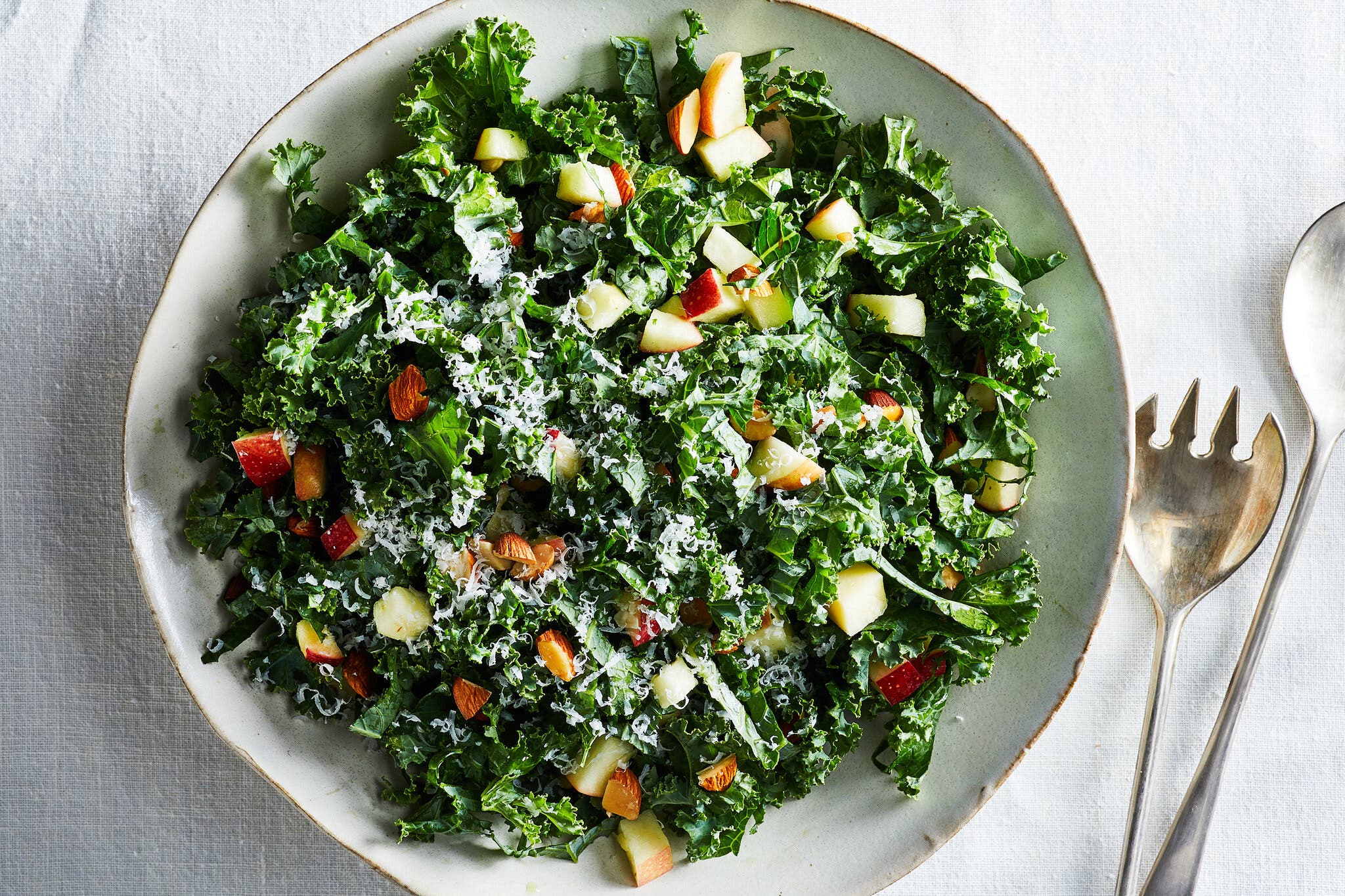
Martha Rose Shulman’s kale salad with apples and Cheddar.Julia Gartland for The New York Times. Food Stylist: Ali Slagle.
You may not remember a time before kale salad, but it appeared only around the turn of this century. In 2001 or so, the chef Mark Ladner had a lemony version on the menu at Lupa in New York City, and in 2007, Melissa Clark wrote in The Times about the chef Joshua McFadden’s Tuscan kale salad. At that time, she struggled to track down the right type of kale to make it. Now, we can’t escape the dark frilly leaves — for good reason. Not only do they hold up in a make-ahead meal, but also they taste great with nearly any dressing or mix-in. The original, a simple mix of kale, lemon, olive oil, garlic, toasted crumbs and cheese, still holds up, and the endless variations have improved desk lunches everywhere since. G.K.
Eric Kim recommends crunchy Little Gem lettuce for this dressing but notes that tender baby spinach or spring mix also tastes great.
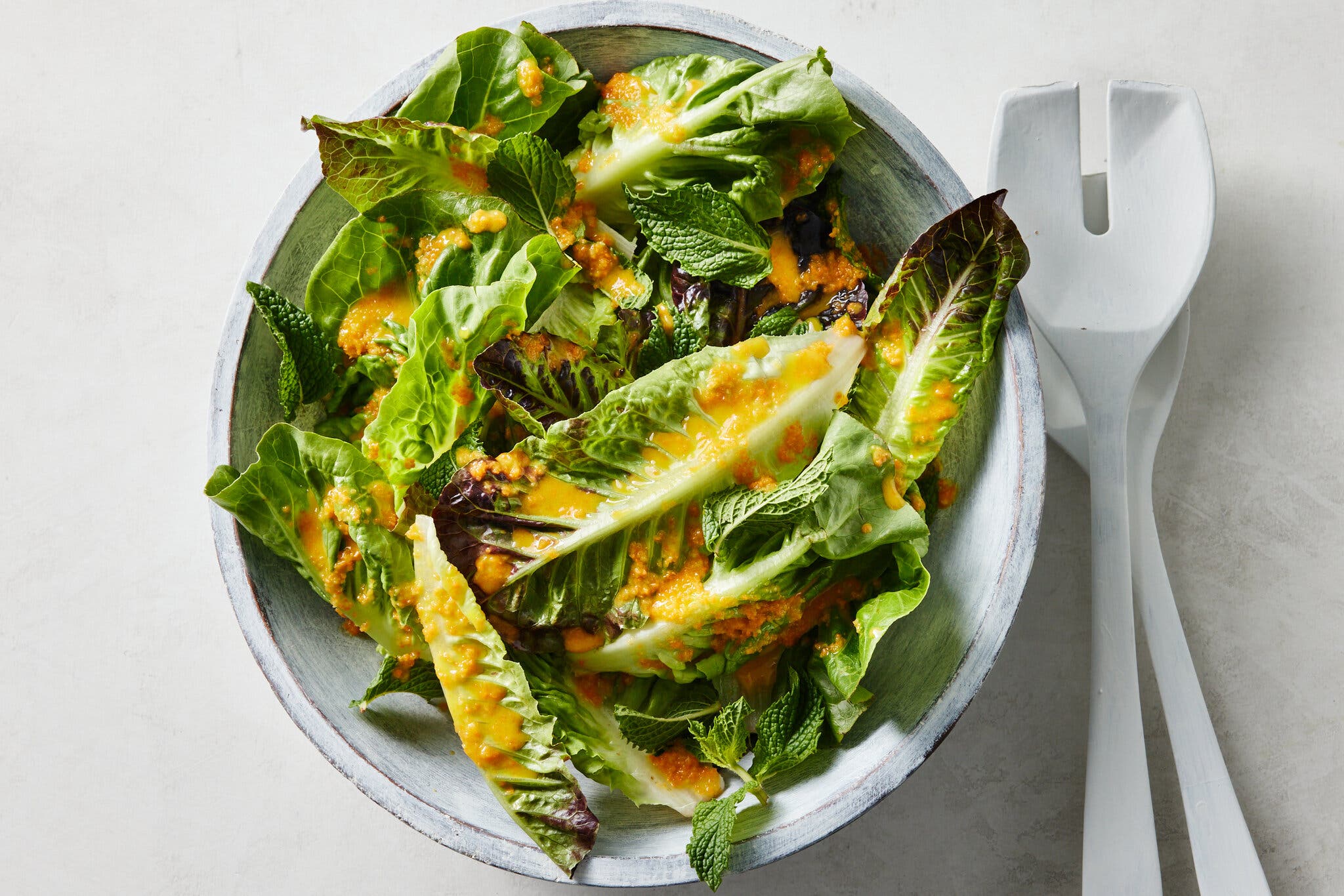
Eric Kim’s crunchy greens with carrot-ginger dressing.Bobbi Lin for The New York Times. Food Stylist: Eugene Jho. Prop Stylist: Christina Lane.
This gingery carrot dressing is so closely associated with sushi counters that it’s sometimes affectionately referred to as sushi restaurant salad dressing. But only in America. While its origins remain unknown, it became popular in the 1960s through Benihana, the Japanese chain that’s as much teppanyaki theater as it is restaurant, and remains a given with meals there. A little sweet and comfortingly thick with puréed carrot, this dressing comes together quickly in a blender and is worth keeping on hand for its versatile, fresh zing. G.K.
If you love green salads with carrot-ginger dressing, you may also love these recipes: Kale Couscous and Tofu Salad With Carrot-Ginger Dressing | Miso-Ginger Dressing
Alexa Weibel emulsifies feta into the dressing for this fresh wedge salad, so it fills the iceberg lettuce’s nooks and crannies.
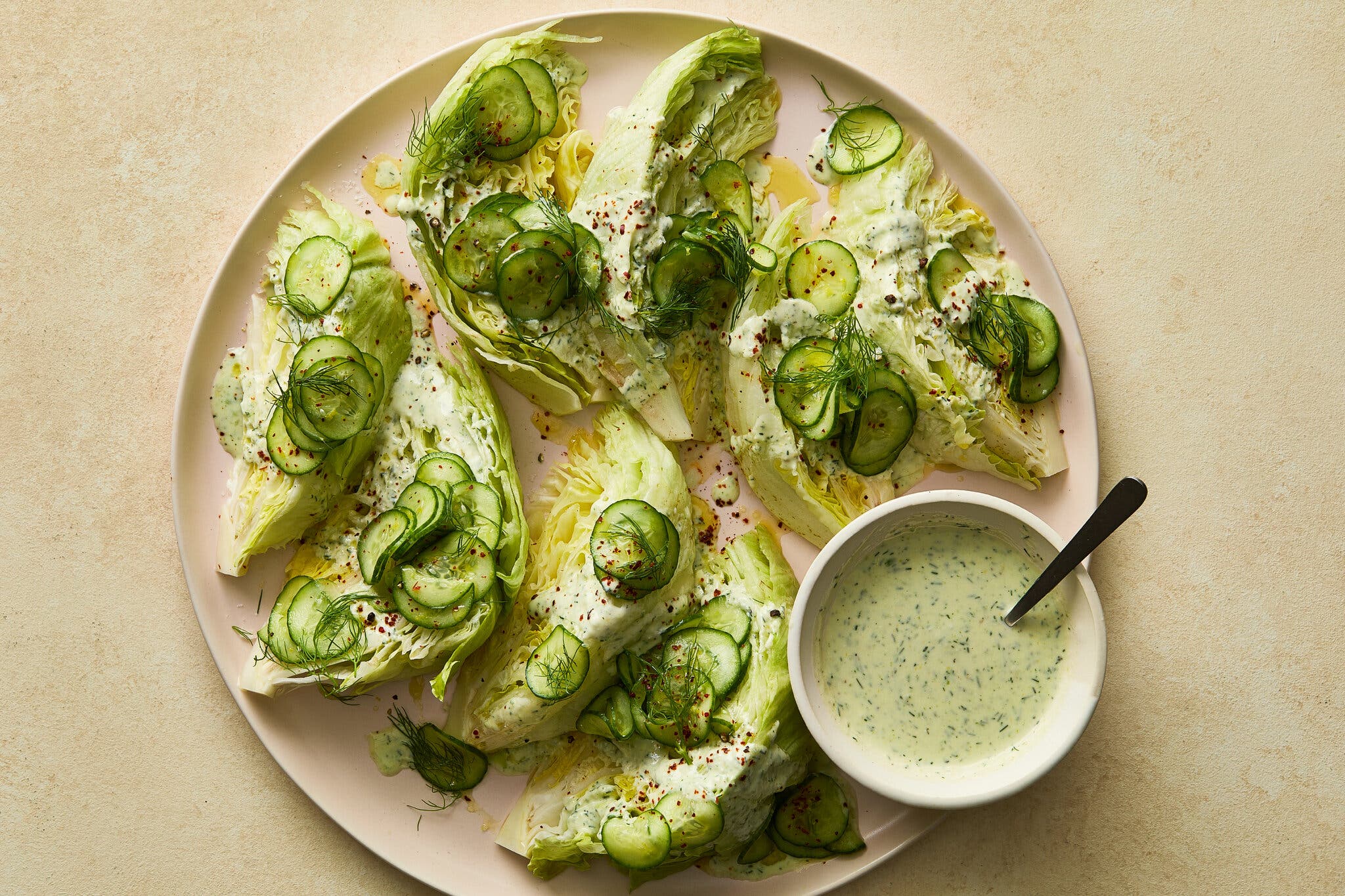
Alexa Weibel’s feta-ranch wedge salad.Armando Rafael for The New York Times. Food Stylist: Simon Andrews.
The wedge salad is, visually, a show-stopper: structural, towering and as groundbreaking as lettuce gets. (Iceberg lettuce wedged its way into American hearts in the 1940s, about 50 years after its introduction, for its ability to survive cross-country travel.) Loaded with a tumble of salty toppings, this salad was later popularized at steakhouses, but it’s also delicious (and easy) enough to make in your home kitchen. Its base is nonnegotiable — crisp, mildly flavored iceberg wedges that accommodate its bold cohorts — yet its dressing and toppings need not be limited to cherry tomatoes, bacon and blue cheese. Tradition dictates a lofty wedge, with its tip at the top, but modern wedge salads like this feta-ranch version heed gravity, spreading horizontally to allow the dressing to better permeate, and to keep the toppings on top where they belong. ALEXA WEIBEL
Alexa Weibel’s vibrant recipe mixes true ease of eating with bursts of spice from jalapeño and crunch from radishes and tortilla chips.
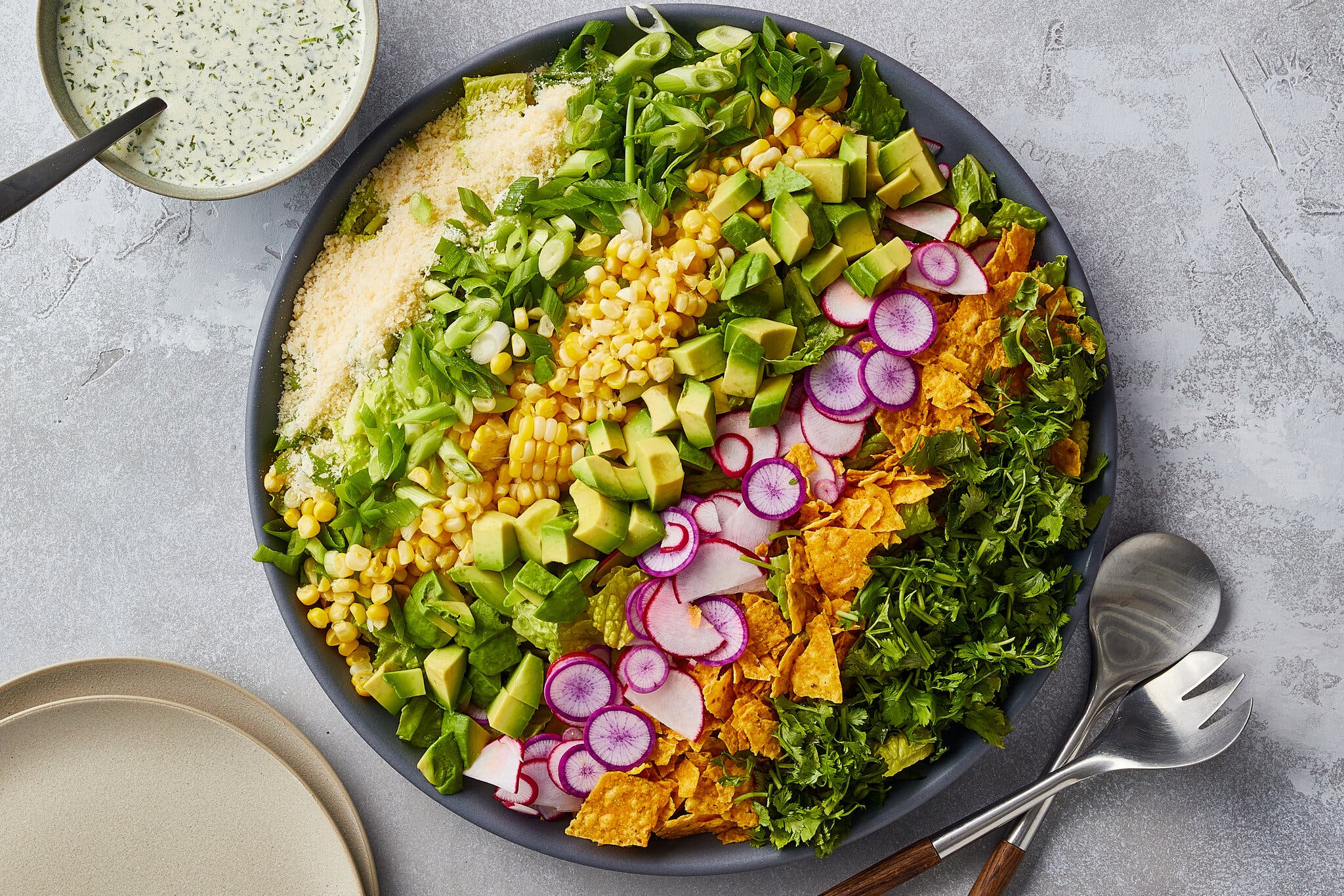
Alexa Weibel’s chopped salad with jalapeño-ranch dressing.Bryan Gardner for The New York Times. Food Stylist: Barrett Washburne.
Based on its ubiquity at fast-casual restaurant chains, the chopped salad may seem like it’s been around forever, but it supposedly got its start in the 1950s, when the owner of the Beverly Hills restaurant La Scala created it for his celebrity guests. They wanted a salad that was less likely to ruin their clothing, what with the messy business of cutting their lettuce with a knife and fork. What emerged was a salad whose low-lying profile is the polar opposite of today’s towering restaurant constructions. CATHY LO
Lidey Heuck’s version of the classic includes red onion, an optional eighth ingredient, whose sharpness contrasts nicely with the creamy dressing, cheese and bacon.
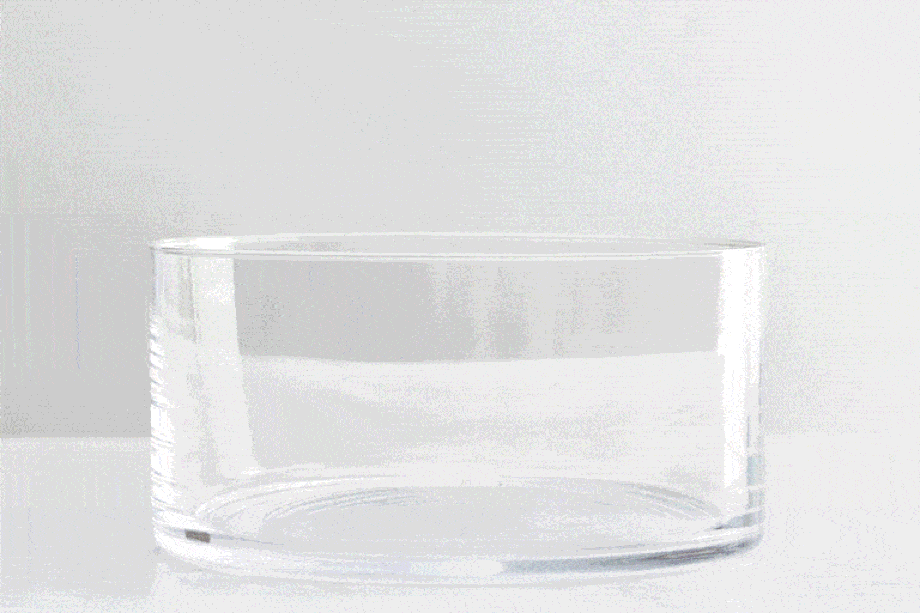
Lidey Heuck’s seven-layer salad.Armando Rafael for The New York Times. Food Stylist: Simon Andrews.
No one knows for sure if this colorful assembled salad originated in the American South or the Midwest, but it’s possible that it evolved, over many years, from salmagundi, a large, artfully composed salad popular in 17th-century Britain. Stacking ingredients in distinct layers not only looks pretty, but it also keeps the components fresh and in their place until you’re ready to serve. M.L.
If you love layered salads, you may love these recipes: Tomato and Cottage Cheese Salad | Caviar Pie
Gabrielle Hamilton considers the chef salad the greatest meal salad of all time, and her version combines good jarred tuna and artichokes with green beans, potatoes, tomatoes, radishes and greens.

Gabrielle Hamilton’s sous-chef salad.Linda Xiao for The New York Times. Food stylist: Sue Li. Prop stylist: Nicole Louie.
Before the chef Louis Diat of the Ritz-Carlton in New York popularized the chef’s salad of ham, turkey, Swiss cheese and boiled eggs in the 1940s, there was the Cobb. A decade earlier, the Cobb was born at the Brown Derby restaurant in Hollywood, a celebrity haunt owned by Robert Cobb. Whether he or one of his chefs created the salad remains up for debate, but its composition of chopped lettuce, tomato, bacon, boiled egg, chicken and avocado with crumbled blue cheese is incontrovertibly delicious. One legend starts with Mr. Cobb scrounging for a midnight meal from the odds and ends in the restaurant’s kitchen, and that sounds about right, since this combines a lot of prepped ingredients. It would also explain why this hearty meal with California vibes is often referred to as a chef salad, too. G.K.
If you love Cobb salad, you may also love these recipes: Cobb Salad | Post-Thanksgiving Cobb Salad
For this vibrant chicken salad, Zaynab Issa was inspired by the classic Halal cart combination of Afghan chicken kebabs and white sauce.
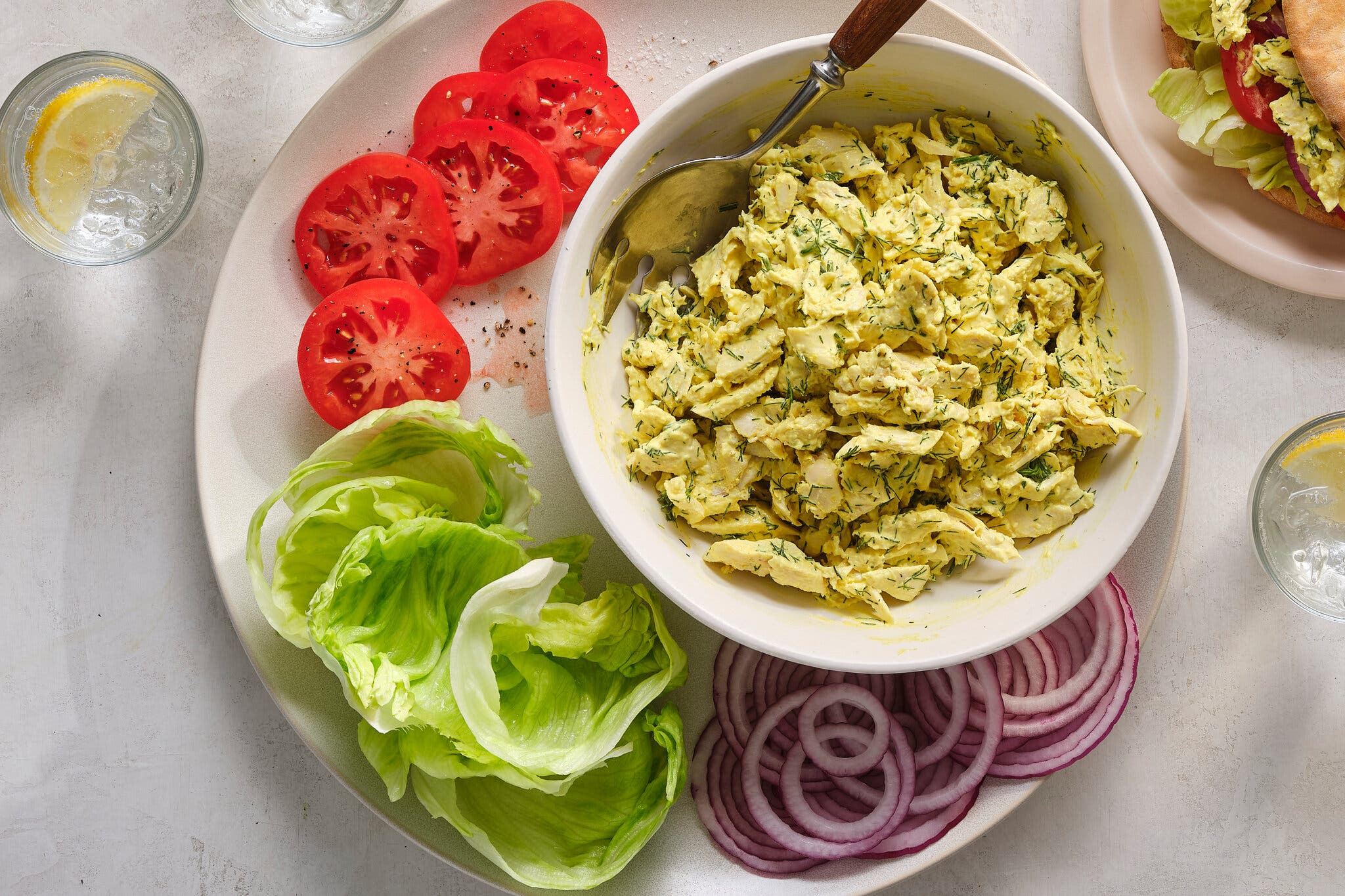
Zainab Issa’s lemon turmeric chicken salad.Nico Schinco for The New York Times. Food Stylist: Kaitlin Wayne.
The beauty of chicken salad is that you’re just as likely to find it at a New York City diner as you are at a Junior League luncheon in Valdosta, Ga. The additions may vary — grapes, nuts, curry powder, apples and more — but the overall vibe is the same: cold and creamy, and it will get you through the rest of the day without you feeling sluggish. In the early 1900s, frugal home cooks combined leftover chicken, ham and fish with mayonnaise to serve atop lettuce leaves for the next day’s lunch. (This is probably why this mostly white mishmash we know today is called a “salad.”) During World War II, luncheonettes looking to cater to the growing female work force started serving versions made with canned tuna and hard-boiled eggs, eventually tucking them in between pieces of bread for portability and convenience. MARGAUX LASKEY
To maximize the crunch of this salad, Sohla El-Waylly starts with a base of corn chips, piles on all the fixings then finishes it off with more chips.
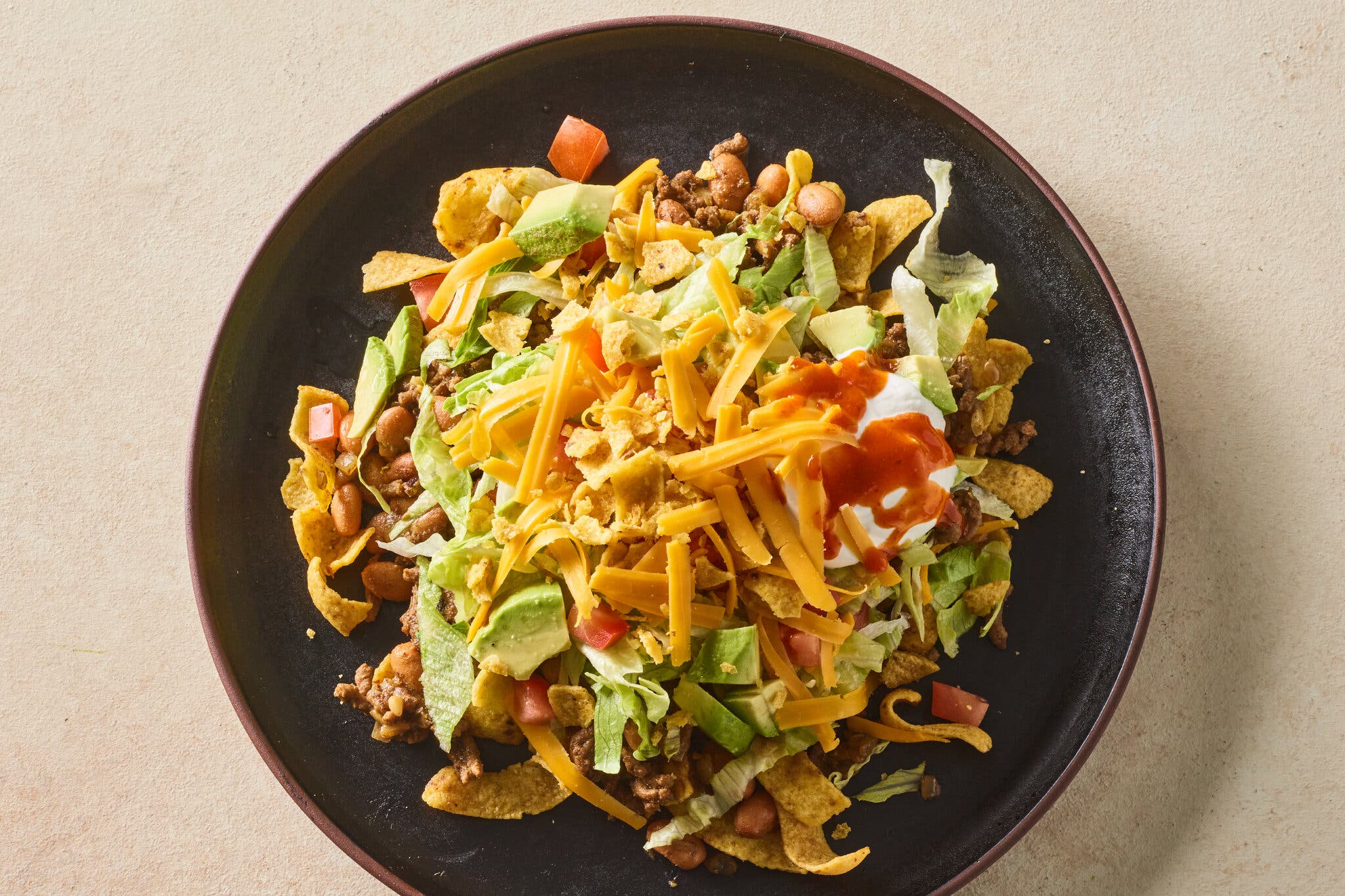
Sohla El-Waylly’s taco salad.James Ransom for The New York Times. Food Stylist: Maggie Ruggiero
There’s the tostada, a crunchy, flat corn tortilla with a molehill of toppings, and there’s the tostada salad, a crisp-fried flour tortilla pleated into a tall bowl that cradles a mountain of meat, beans, cheese, tomatoes, shredded lettuce and sour cream. Here, then, is a happy medium of tostada salad fixings with the tostada crunch of corn chips. First sold in 1955 at Disneyland’s Casa de Fritos, a restaurant from a Frito company founder, the concept quickly spread to other restaurants. As a mainstay in kitchens everywhere, the taco salad captures the childlike joy of American Mexican home cooking. G.K.
Julia Moskin interviewed cooks from Thailand and Laos for this classic take on som tum, where the seasonings are crushed and the papaya is simply stirred in to retain more crunch.
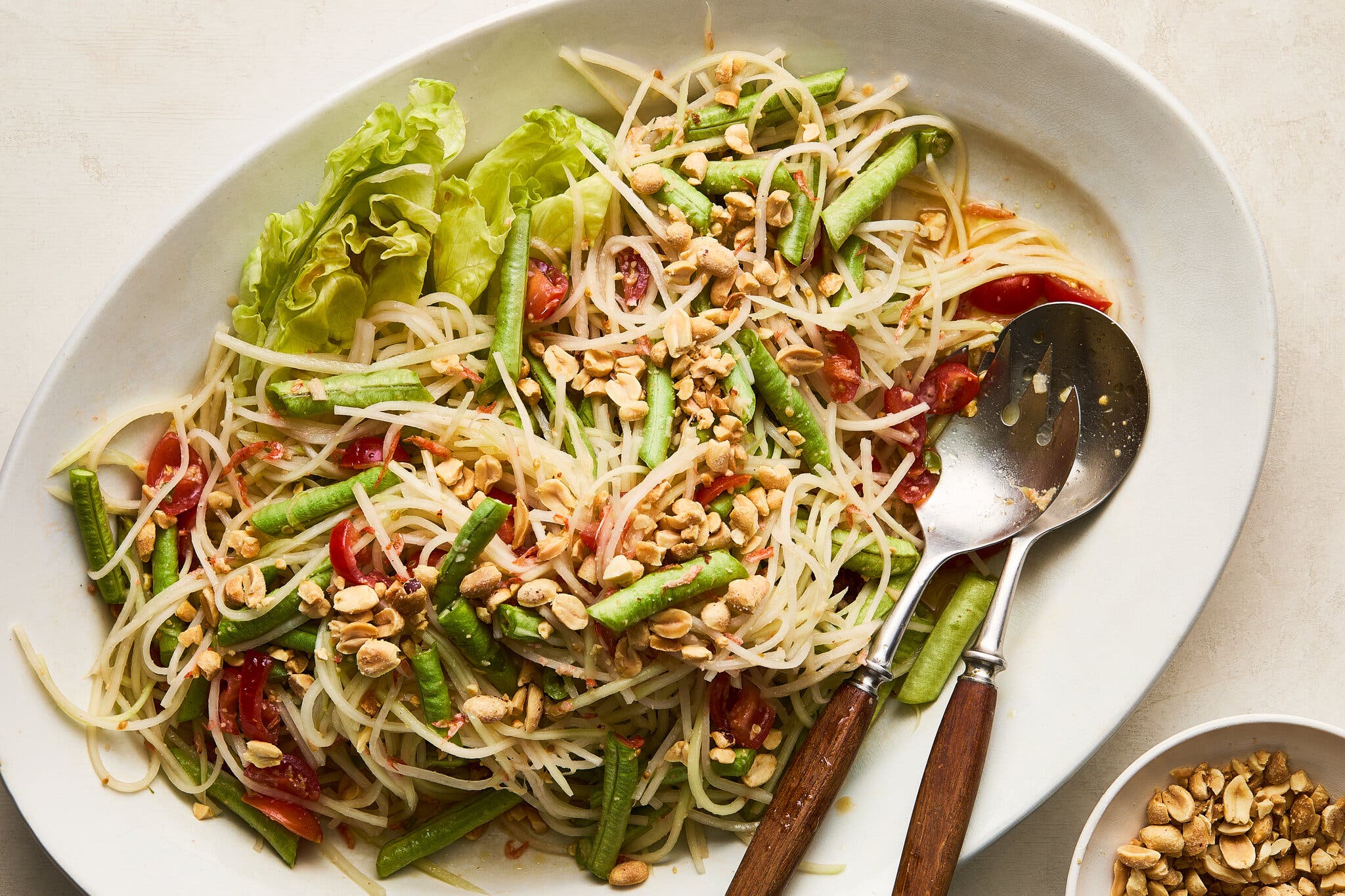
Julia Moskin’s som tum (green papaya salad).Armando Rafael for The New York Times. Food Stylist: Simon Andrews.
Spicy, sour, salty and sweet, this northeastern Thai dish, popular throughout Southeast Asia, stars crisp shreds of unripe papaya mixed with a punchy dressing of garlic, sugar, fish sauce, lime juice and chiles. The salad, which most likely originated in nearby Laos, has many versions, including ones with preserved black crab or pineapple. But traditionally, the papaya and the aromatic ingredients are pounded with a mortar and pestle — som tum roughly translates to “pounded sour”— allowing the fruit (and any accompanying vegetables) to release some of their juices and to better absorb the dressing. C.L.
If you love som tum, you may also love: Green Papaya Salad
Hetty Lui McKinnon’s version vegetarian version of gado-gado uses pan-fried tofu, boiled eggs, bean sprouts, cabbage and potatoes.
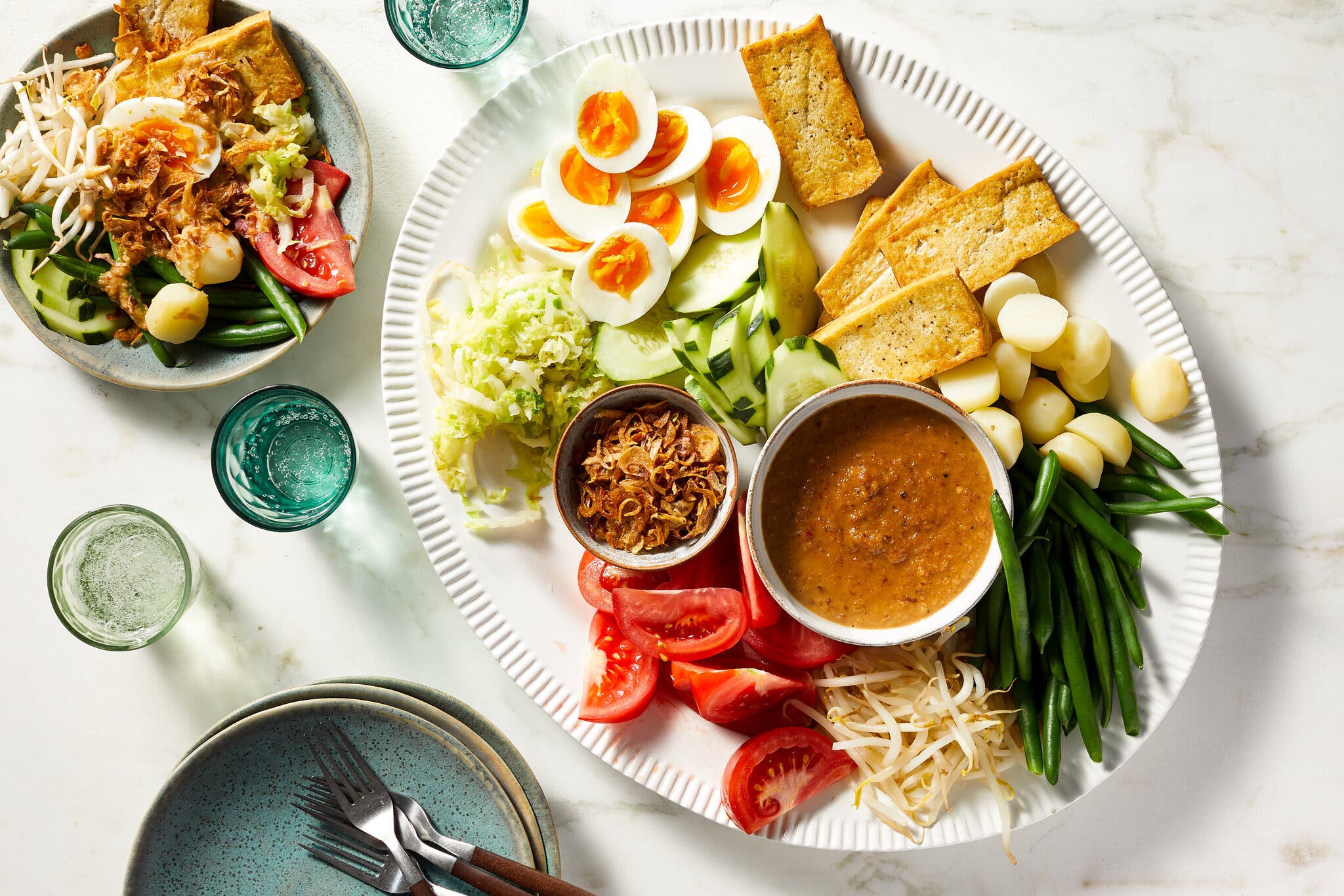
Hetty Lui McKinnon’s gado-gado.Christopher Simpson for The New York Times. Food Stylist: Simon Andrews.
Like all the best salads, gado-gado, a national dish of Indonesia, relies on variety (in fact, its name translates to “mix-mix”). A kaleidoscopic tumble of vegetables, it will vary from cook to cook, but at its core, there’s one constant: The components are doused in a stellar sweet-and-spicy peanut sauce that is typically spiced with chiles and sweetened with kecap manis, a blend of soy sauce and sugar, and accommodates any number of ingredients. A.W.
If you love gado-gado, you may also love: Green Bean and Tofu Salad With Peanut Dressing
This pork laab from Sherry Rujikarn is easy and versatile: You can swap in ground chicken or tofu for the pork, and scale the lime juice, fish sauce and herbs to taste.
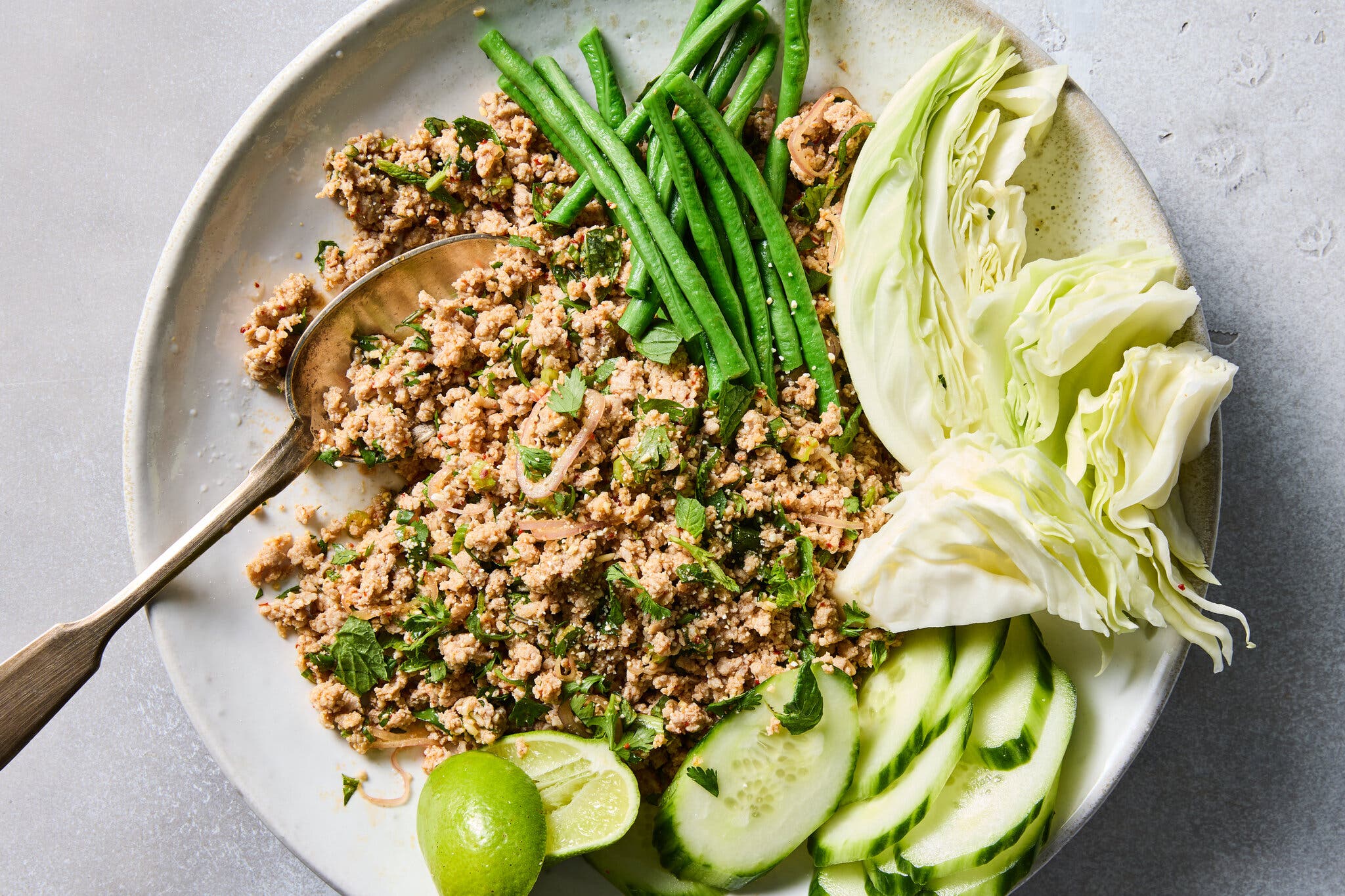
Sherry Rujikarn’s pork laab.Christopher Testani for The New York Times. Food Stylist: Simon Andrews.
An intoxicating combination of minced meat, toasted rice powder, lime juice and fresh herbs, heartily high-protein laab is a salad that fuels you. Reputed to have roots in Laos, the dish is also native to Isan, in northeastern Thailand, where lime is employed heavily in laab and som tum alike. Laab is often served with sticky rice and a slew of fresh vegetables, including green cabbage, long beans, sliced cucumber and lettuce, but you can customize the greens as you like. A.W.
Though many versions recommend store-bought fried noodles, Eric Kim’s crispy wonton chicken salad calls to slice and fry wonton wrappers for a delicate crunch, and to sweeten the dressing with a spoonful of peach or apricot preserves.
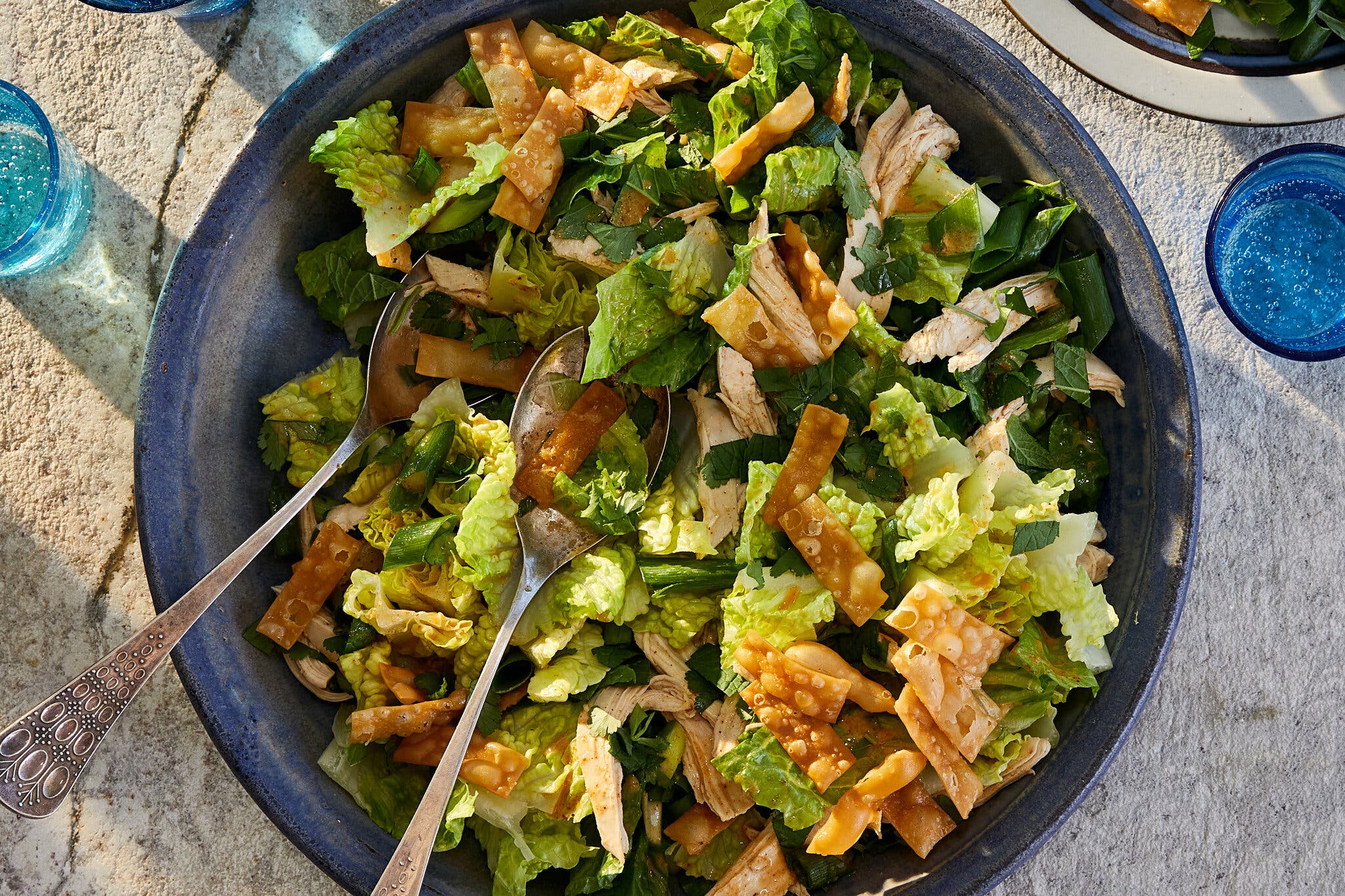
Eric Kim’s crispy wonton chicken salad.Chris Simpson for The New York Times. Food stylist: Maggie Ruggiero. Prop stylist: Sophia Pappas.
Long before you could have your salads made to order at a Sweetgreen counter, Cary Grant requested a “Chinese chicken salad” from Madame Wu’s Garden, Sylvia Wu’s celebrated Los Angeles restaurant. His customized chicken salad included rice noodles, fried wonton skins and scallions, slicked with a zippy soy-and-sesame dressing, but the dish has continued to evolve over time. Inaccurately named and inarguably American, Chinese chicken salad can today be spotted at the mall, at chain restaurants or at cookouts and potlucks — it’s a salad that parties. It also doesn’t take itself seriously, a whimsical heap of slivered greens, chicken, crispy fried wontons and herbs, coated in a salty-sweet dressing that still typically includes soy sauce and sesame. A.W.
If you love Chinese chicken salad, you may also love these recipes: Crunchy Noodle and Tofu Salad | Chinese Chicken Salad
In her version, Melissa Clark doesn’t choose just tuna or anchovies. Rather, she features the larger fish and blends the smaller into the dressing, increasing this salad’s protein punch.
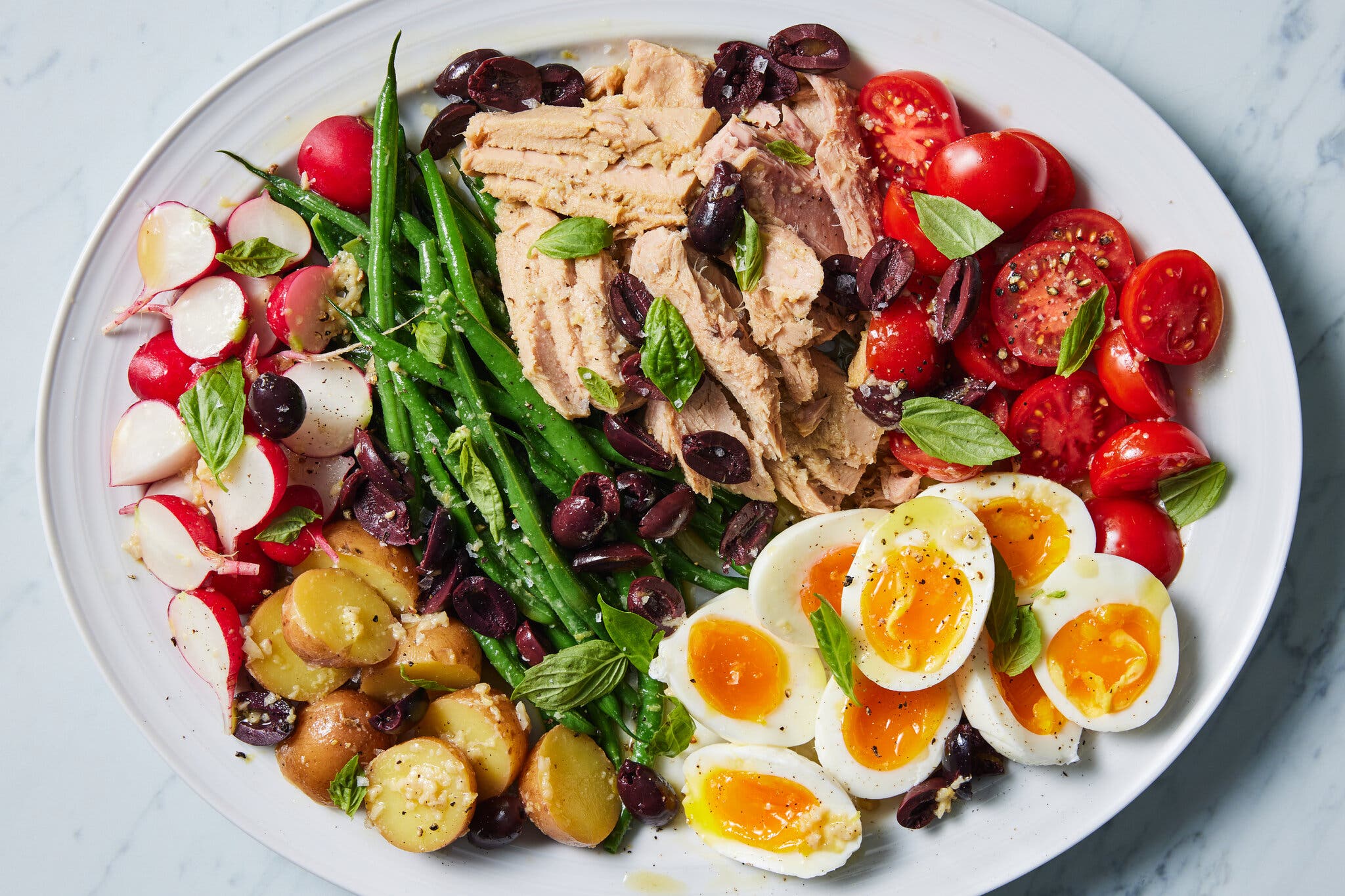
Melissa Clark’s Niçoise salad with basil and anchovy-lemon vinaigrette. Christopher Testani for The New York Times. Food Stylist: Simon Andrews.
This sunny salad is at its best when tomatoes are fat, juicy and sweet, as they would be from basking in the summer sun in the south of France, where this salad originates. Tomatoes, olives and tuna (or anchovies) are traditional, along with any raw vegetables the cook desires, but potatoes, green beans and hard-boiled eggs are practically expected. The added ingredients create a particularly hearty warm-weather meal, ideal for making ahead and porting to a picnic. C.L.
Classic three-bean salad is made with sugar-vinegar dressing, but Melissa Clark gives hers a decidedly savory French accent with Dijon, shallots, parsley and celery.
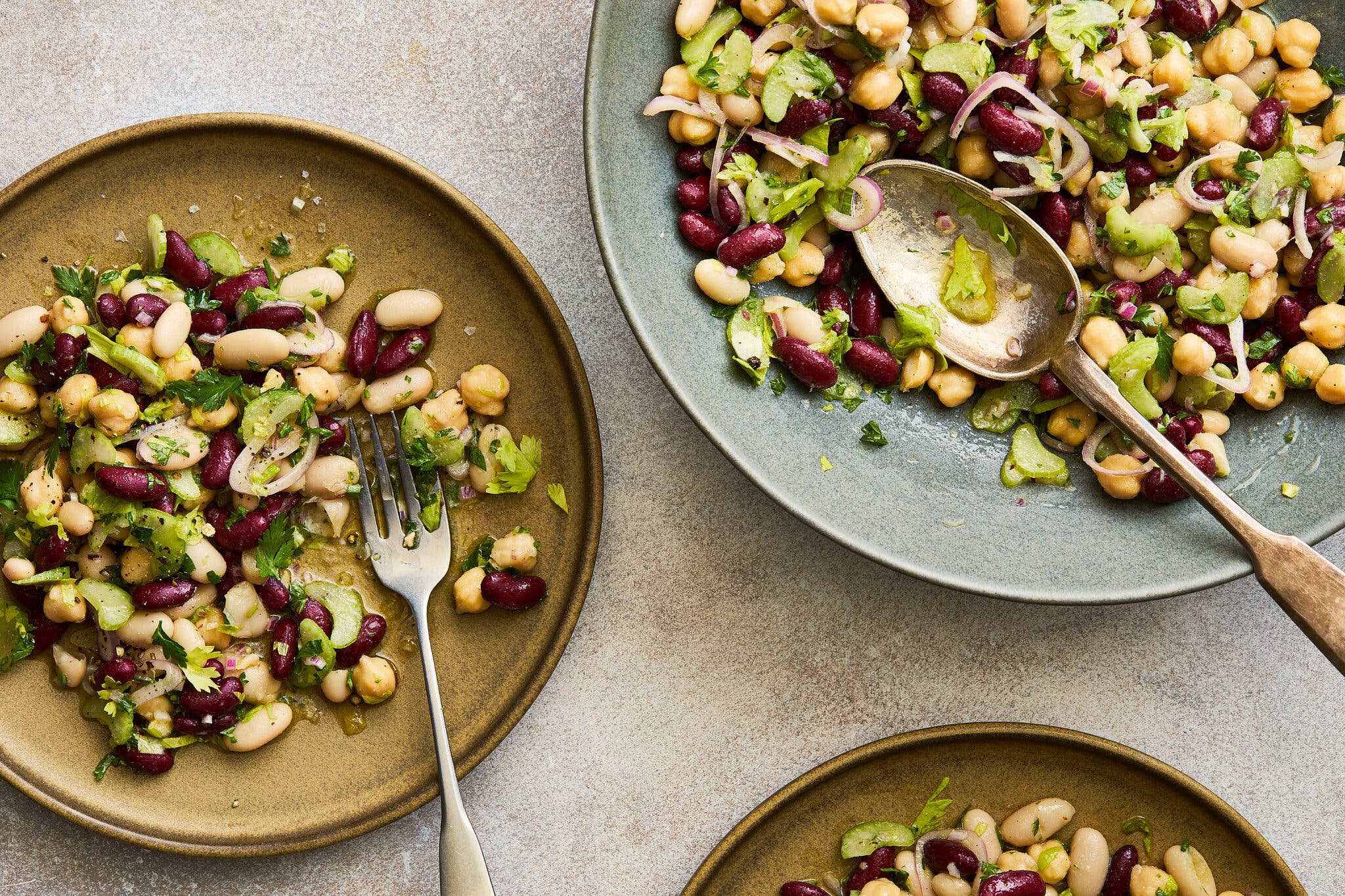
Melissa Clark’s bean salad.Armando Rafael for The New York Times. Food Stylist: Simon Andrews.
Hearty bean salads, a welcome standby at picnics and in lunchboxes, can be traced back to Native American cultures, whose agriculture relied heavily on beans. Three sisters salad was named after the ancient “three sisters” method, which entailed planting corn, beans and squash together in a way that benefited all three crops: The corn provided a stalk for the beans to climb, large squash leaves provided shade and discouraged weeds, and the beans helped stabilize the corn stalks. Bean salads, now typically made with inexpensive canned beans, remain popular for many good reasons: They’re economical, they get better as they sit, they serve a crowd and they’re happily riffable. M.L.
Martha Rose Shulman’s Lebanese tabbouleh is a best-in-class version, ensuring a high ratio of herbs (parsley and mint) to bulgur.
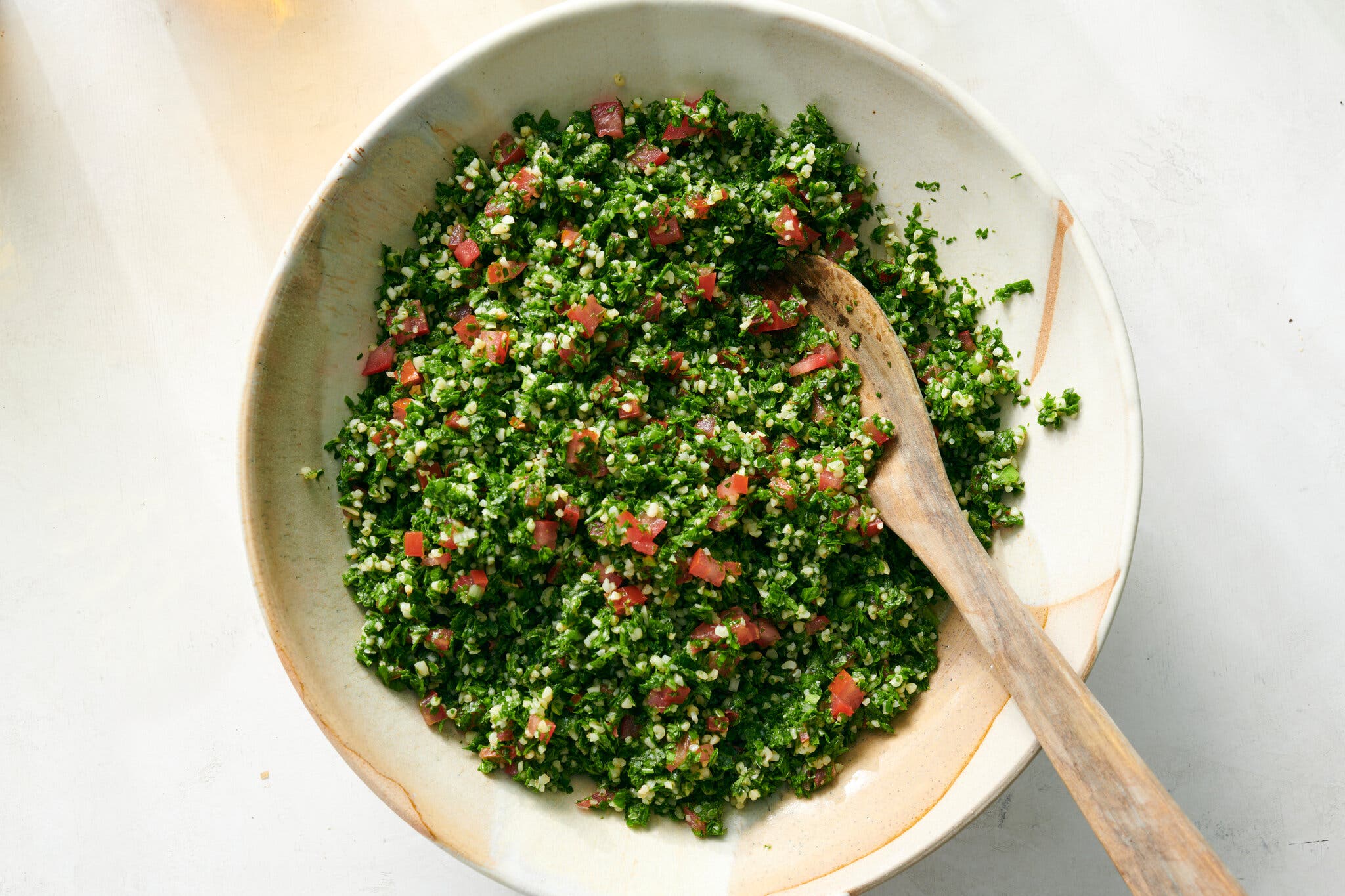
Martha Rose Shulman’s tabbouleh.David Malosh for The New York Times. Food Stylist: Simon Andrews.
This classic Middle Eastern salad combines bulgur wheat with diced tomatoes, lemon, olive oil, and piles and piles of fresh herbs, chopped until diminutive enough to be consumed by the spoonful. The dish may even predate the Middle Ages, yet its combination of acidity and greens still feels fresh today. Though lemon juice jolts any salad to life, it can also dim the brightness of the greens, so this salad, like many others, is best enjoyed close to its creation. A.W.
Gabrielle E. W. Carter uses watermelon and tomato in her country panzanella for even juicier, sweet-savory notes in every bite.
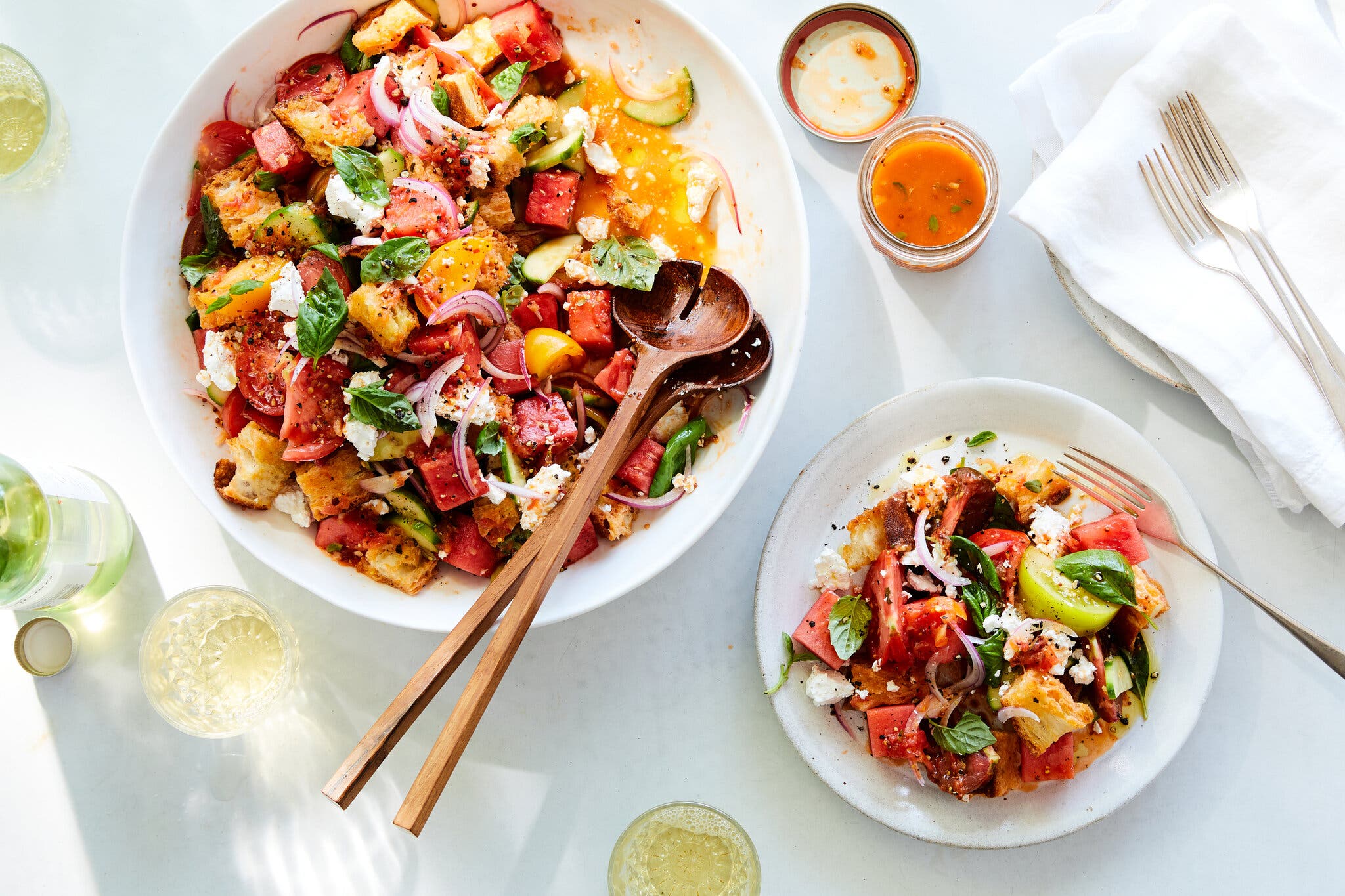
Gabrielle E.W. Carter’s country panzanella with watermelon dressing.Ryan Liebe for The New York Times. Food Stylist: Simon Andrews.
The Tuscan painter and poet known as Bronzino first wrote about a salad of stale bread, onions, cucumbers and leafy greens like purslane in the 16th century (tomatoes weren’t included, since they had only recently been introduced to Italy). Unlike crunchy croutons, the bread in panzanella, now a Tuscan classic, is the main event, soaking up the vibrant juices from summer produce and becoming equal parts chewy and juicy. And since panzanella and its pita-based cousin, fattoush, tend to improve as they sit, they’re especially easygoing, ready to take to the beach or wait patiently in the fridge for post-pool snacking. ADINA STEIMAN
Millie Peartree’s classic adds sweetness with carrots and a bit of sugar; celery and bell pepper provide fresh crunch.
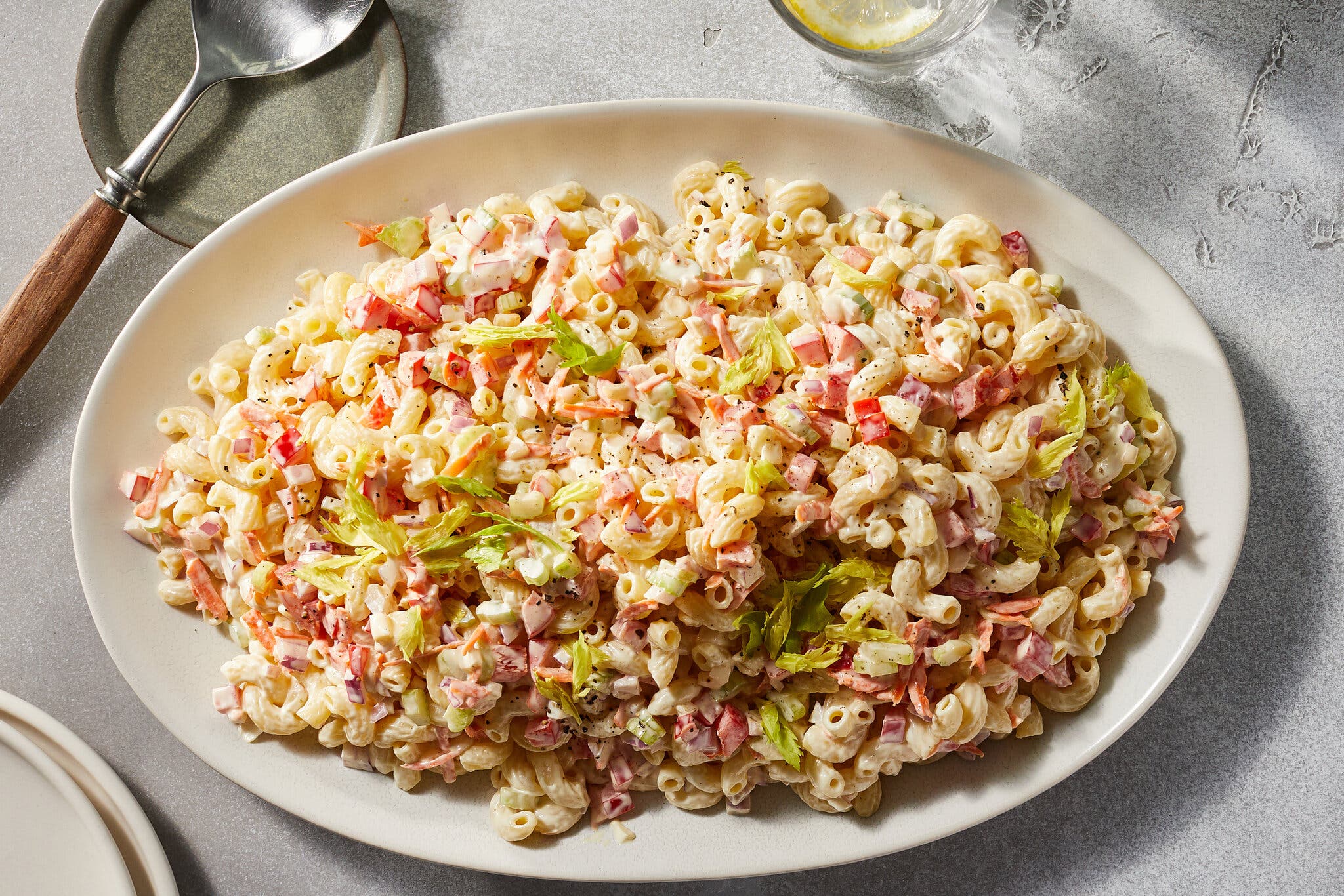
Millie Peartree’s macaroni salad.Christopher Simpson for The New York Times. Food Stylist; Simon Andrews.
The union of elbow macaroni and a mayonnaise-based dressing is such a staple at deli counters and on picnic blankets that this American pasta-salad spinoff has naturally engendered its own riffs. In Hawaii, the pasta is cooked until soft (never al dente), and mayo is more than a binder, but a flavor of its own. Shrimp can be added for heft and a bit of protein, but no-cook options like canned tuna and peas are smart mix-ins. C.L.
Melissa Clark’s light, refreshing lemony potato salad adds extra flavor with a mint-scallion finish.
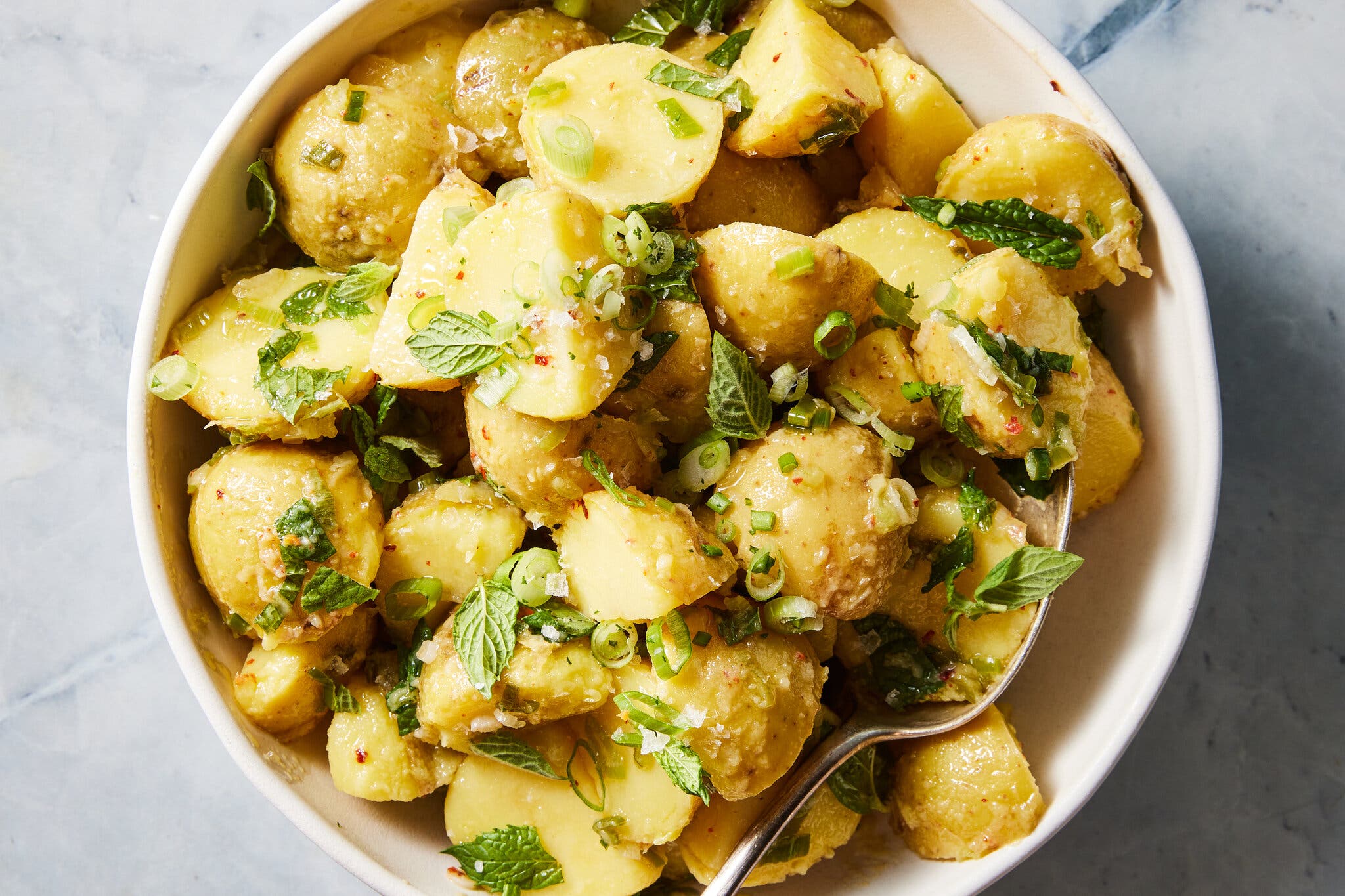
Melissa Clark’s lemon potato salad with mint.Christopher Testani for The New York Times. Food Stylist: Simon Andrews.
The potato salad has had a long time to sit and marinate: Mention of potatoes boiled and dressed in oil and vinegar date back as early as the 17th century, but the salads as we know them gained popularity in America in the second half of the 19th century. These days, there’s a potato salad for every taste: served warm or cold, accented with bacon fat, mayonnaise or a simple vinaigrette. Most recipes call for waxy potatoes that hold their shape, but starchy russets aren’t unheard-of, and, in some cases, the potatoes aren’t in cubes but broken down to a chunky mash. C.L.
Lidey Heuck’s take, heady with briny olives and slabs of feta, is just one of a larger genre of tomato-cucumber salads popular throughout the world.
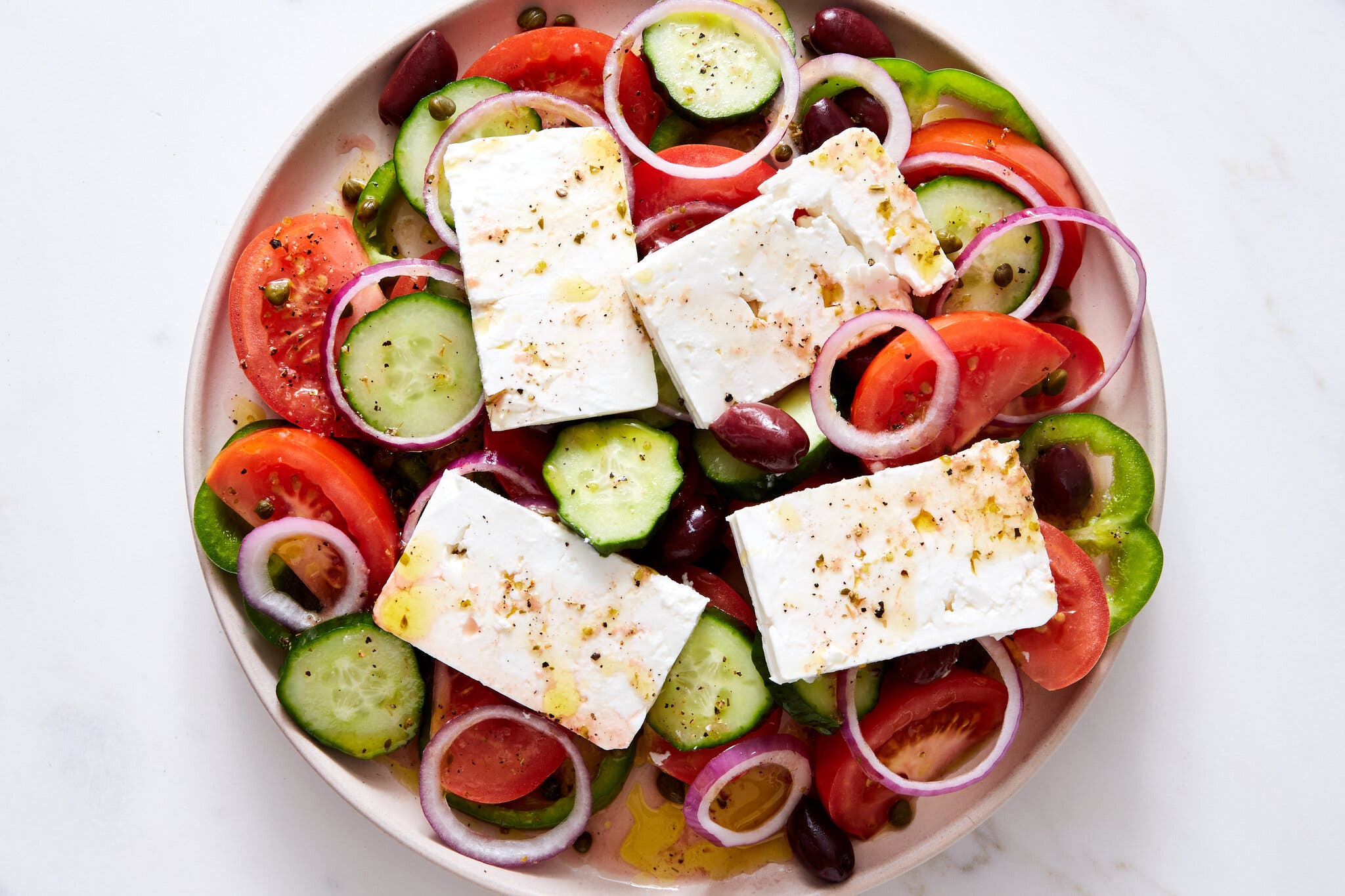
Lidey Heuck’s Greek salad.Yossy Arefi for The New York Times (Photography and Styling)
In summer, tomato and cucumber — technically both fruit — are drawn together with an almost magnetic force, an edible antidote to heat. The combination, finished with a pour of olive oil and a sprinkle of salt, is found across the Eastern Mediterranean, the Middle East and beyond. In Greece, it’s called horiatiki salata, or “tavern salad,” and topped with a slab of briny feta, a splash of vinegar and a sprinkle of dried oregano. In other nearby countries, the two ingredients are often finely diced and tossed with plenty of tender herbs and citrus juice, ready to serve as a spoonable salad. But one truth is universal: In high summer, it’s a sin not to save and slurp the gazpacho-ish juice at the bottom of the bowl. A.S.
There is an entire universe that separates Ali Slagle’s fruit salad recipe from the tired versions you might encounter on airplanes, in buffets or at supermarkets.
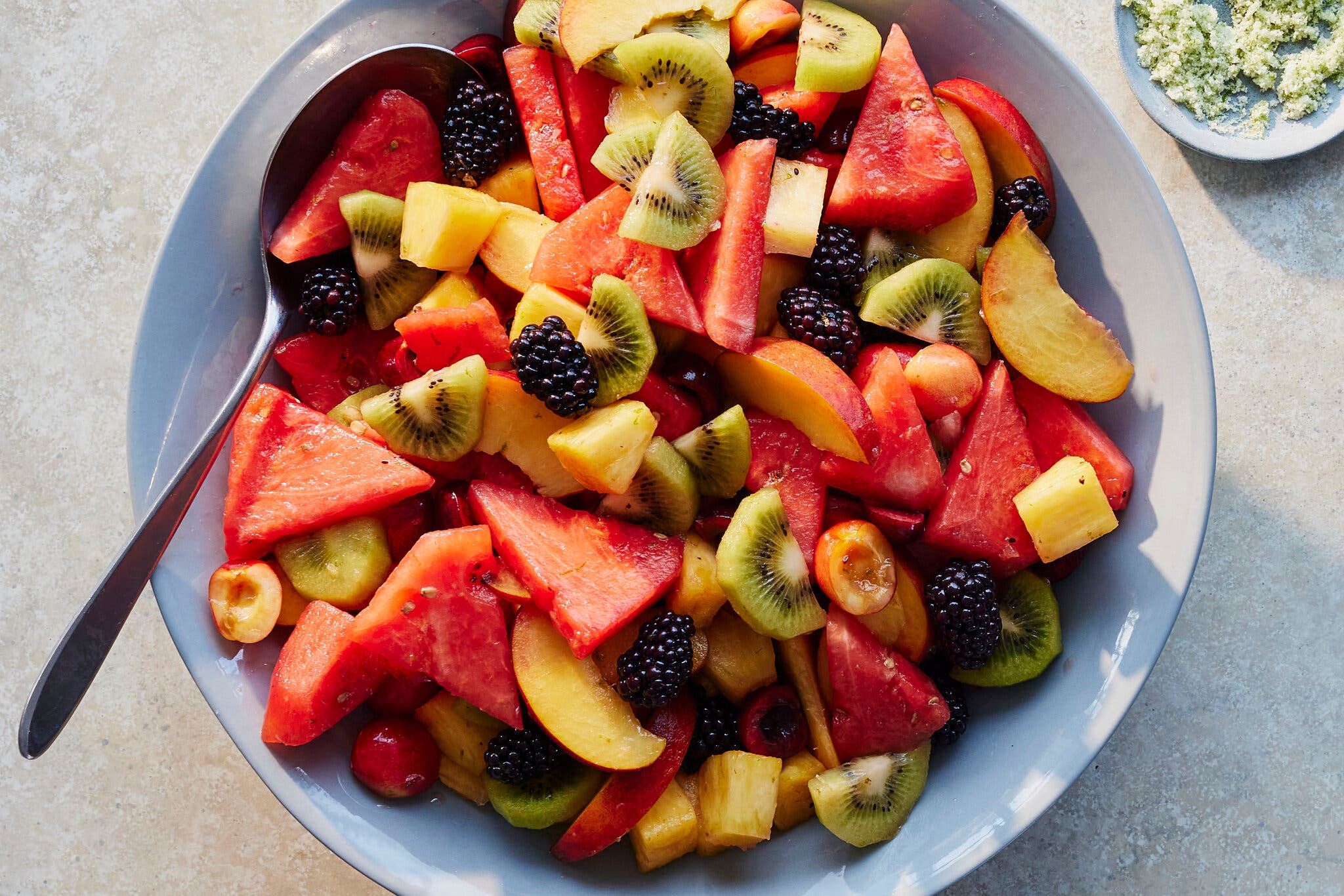
Ali Slagle’s fruit salad.Nico Schinco for The New York Times. Food Stylist: Barrett Washburne.
Fruit salad is both simple and limitless. Technically, you could combine two different sliced fruits and present the results as fruit salad, but you’d be shortchanging yourself on flavor, when it could be intensified with dressing, spices, herbs or vegetables. Ali Slagle spikes her fruit salad with fresh lime zest, lime juice and sugar; the results taste like fruit at its peak, how a salad should make you feel: abundantly alive. A.W.
To ensure each element of Melissa Clark’s Caprese shines, bring the mozzarella to room temperature, sprinkle the tomato slices generously with salt and top the salad with basil at the last minute.
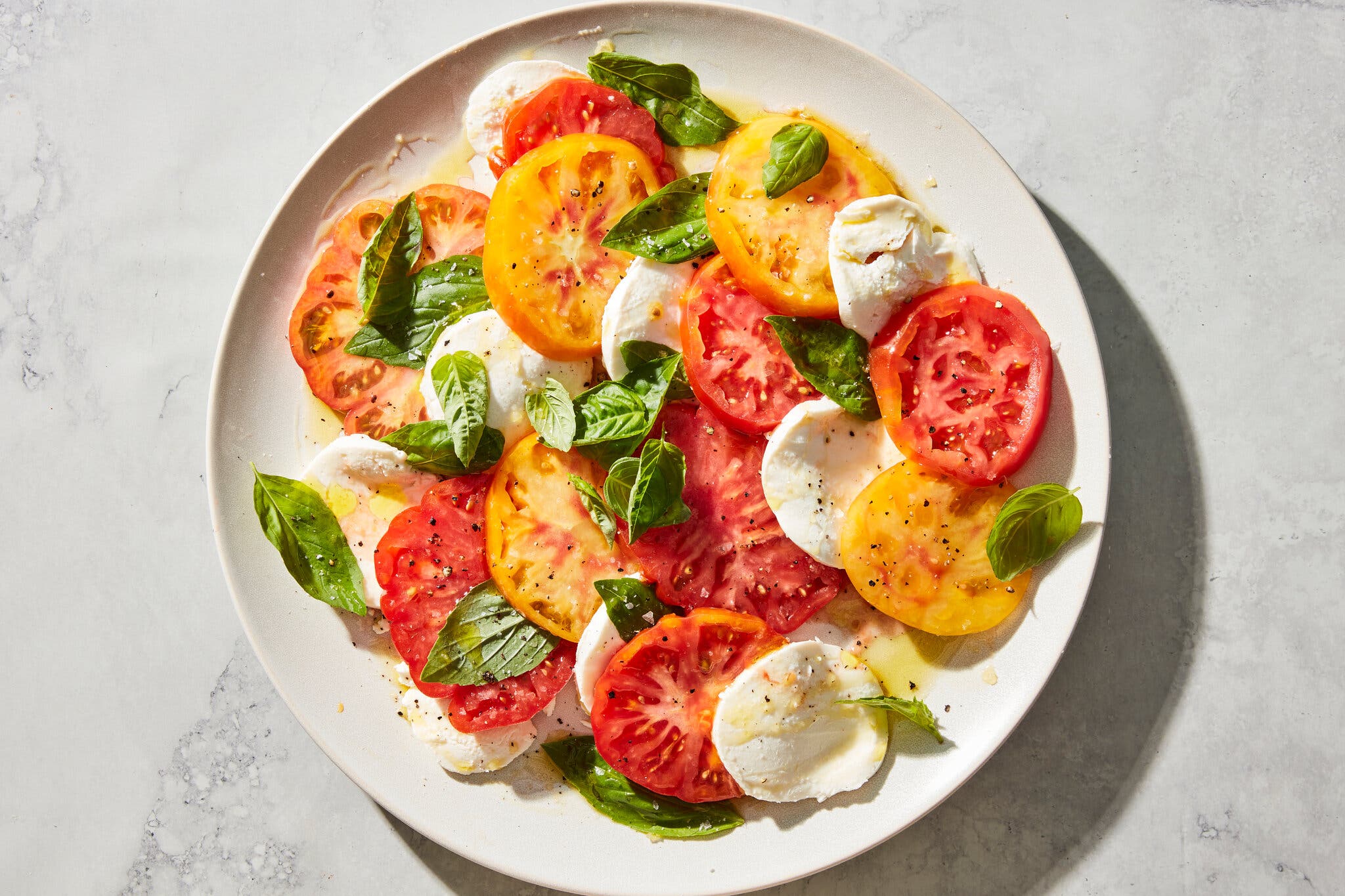
Melissa Clark’s Caprese salad.Christopher Testani for The New York Times. Food Stylist: Simon Andrews.
The essence of effortless summer cooking, Caprese salad demands little from the cook: Cut up a few ripe tomatoes, tear some fragrant basil and slice some milky mozzarella, and all that’s left is to arrange them all on a platter, season and drizzle with olive oil, and admire the sight before you tuck in. The same blueprint applies even if you get restless and swap out the tomatoes for stone fruit, cucumbers or melon, or add more depth with prosciutto, olives or a spicy vinaigrette. A.S.


